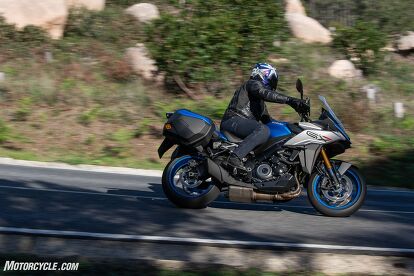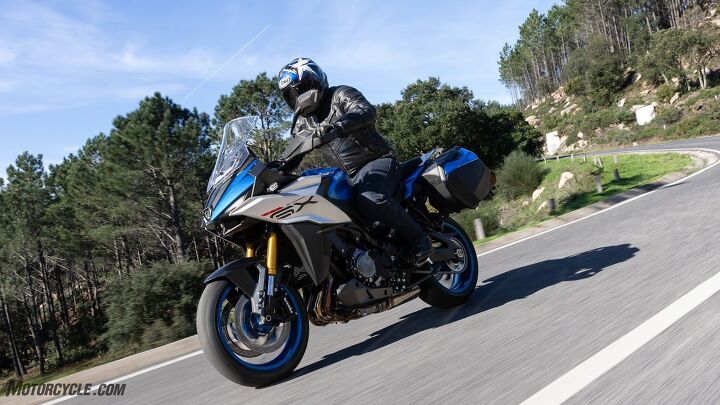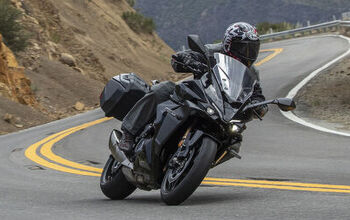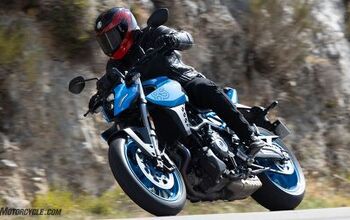2024 Suzuki GSX-S1000GX+ Review – First Ride

A tech-laden, long-legged addition to the K5 family
Suzuki has produced more than 180,000 of its K5 999 cc Inline Four cylinder engine in the last 18 years, and now we’re seeing that engine tasked with powering a tall sport touring bike that Suzuki calls the “supreme sport crossover," sitting between the sport-touring GSX-S1000GT that the GX is heavily based on, and adventure tourers like that of Suzuki’s V-Strom line. Leggy sport tourers, or crossovers, aren’t exactly a new thing, and since bikes like the Kawasaki Versys, Yamaha Tracer 9 GT, and BMW S 1000 XR exist, there is already some healthy competition for Hamamatsu to contend with. Suzuki tells us this is its most technologically advanced motorcycle yet, making the GSX-S1000GX a sort of flagship product for the brand.
2024 Suzuki GSX-S1000GX+
Suzuki’s new flagship “crossover” melds the adventure and sport-touring worlds together with an emphasis on sport.
Editor's score: 88.5%
Engine | 19/20 | Suspension | 13.5/15 | Transmission | 9/10 |
Brakes | 7/10 | Instruments | 5/5 | Ergonomics | 9/10 |
Appearance | 9/10 | Desirability | 9/10 | Value | 8/10 |
Highs
- The K5 engine continues to prove its versatility
- Suzuki’s new tech also aids in the GX’s versatile character
- The sporty side is still there from the GT, just with more comfort
Sighs
- Vague front brake feel continues to be an issue
- The stock seat shape creates some discomfort over time
- The electronic suspension took a bit more time to dial in than expected
Motorcycle.com would like to thank Motorcycle Mechanics Institute | MMI for sponsoring this video.
Video by Aldo Gonzáles, Adrià Moles, RuggedFrames (Edited by Ray Gauger)
Given that the GX shares major components like the engine, its tune, the swingarm, and main frame from the GT, which won our 2022 Sport Touring MOBO as well as runner-up for our for Motorcycle of the Year last year, we were pretty certain the GX was going to be a winner out of the gate. Of course, that didn’t stop Yours Truly from accepting an invitation to ride the bike around the Portuguese Riviera to confirm our suspicions.
Standout Features
“Most technologically advanced,” you say? Don’t worry, I’ll feed ya, baby bird. Really, that claim centers around the Suzuki GSX-S1000GX’s six-axis IMU which informs systems like the cornering traction control and ABS that we’ve come to expect. More importantly, it’s the brains behind the GX’s next biggest piece of tech, the electronic semi-active Showa suspension – a first for any Suzuki motorcycle. Other significant changes compared to the GT include things that are a bit more obvious, like the more upright and open rider triangle with better wind protection, a beefed up subframe, and extra suspension travel.
Since tech is the name of Suzuki’s game for the GX, let’s dive into the suspension and Suzuki Intelligent Ride System (SIRS) first. Showa supplies its Electronically Equipped Ride Adjustment (EERA) fork and Balance Free Rear Cushion shock which are electronically adjusted automatically, responding and potentially changing the damping one thousand times per second to match conditions. The shock has three manual preload settings and an auto mode that constantly monitors preload to ensure the proper level is maintained. Both the fork and shock have three damping settings which are tied to the three ride modes, Soft, Medium, and Hard. There is also a custom mode which allows the rider to further adjust the different suspension characteristics.
Because the suspension settings are tied to the ride modes, I found myself flipping between all three fairly often, switching to C or Comfort in town for plush suspension and muted throttle response, and A for Active when the road got curvaceous, though B, or Basic, proved to offer excellent intermediate performance during our highway and backroad cruises. I wasn’t always happy with the stock suspension setting that came with the ride mode, but being able to switch these independently helped with dialing in the feeling I was looking for when the pace picked up.
For me, cranking up the preload rather than staying in auto helped with front end feel. Riders looking to dial their experience further can use the custom mode to alter each damping setting by three levels in each direction. The anti-dive function in the fork also holds the front end up nicely during hard braking, but the ramp up in damping when doing so happens fairly quickly – not like hitting a wall, but you can feel it when it stiffens up.
The SIRS system includes all of the rider aids and modes as well as cruise control, the bi-directional quickshifter, ride-by-wire throttle, and a whole list of acronyms that I refuse to confuse you with. Just know that the IMU is working in conjunction with the suspension, throttle, and engine braking to ensure that the motorcycle maintains composure in a variety of scenarios. During our ride, it did just that. The GX is a comfortable and stable steed no matter the ride and is forgiving should you push it a bit too far. It’s not the fastest to flick back and forth given its long legs and wheelbase, but it’s hardly a slouch either. The riding position is ever so slightly canted forward to show its sporting intentions, but is otherwise as comfortable as it looks. Seat height is 33.3 inches and curb weight is claimed to be 511 without the side cases (the last GT we threw on the MO scales weighed 524 with its cases installed).
Complaints? I have a few…
There were three things that stood out as glaring issues during my time with the GSX-S1000GX. Starting with the most inexcusable is the fact that Suzuki calls the windscreen adjustable, which I guess it is… but you’ll have to do so by unscrewing the four bolts attaching the thing to move it into one of the three settings. Second, the stock seat creates hotspots after only a few hours of riding. The $400 premium seat that we got to sample was better and features a material that doesn’t heat up in direct sunlight which is nice, but it only staved off the pain in my backside slightly longer than the stock seat. Lastly, something we’ve experienced on the GT as well which makes sense given the shared components, is a front brake with little initial bite and vague feel at the lever. The power is there, but the feel is not. To continue to use rubber lines on a “flagship” is inexcusable these days. Steel lines and a pad swap could cure this ailment.
Back to it
Of course we can’t entirely gloss over the sweetheart of an engine that the GX is sporting. The decades old framework of the K5 continues to be a mill we’re happy to feed fuel into. Suzuki tells us the tune is exactly the same as the GT, but the throttle response was changed slightly on the GX. Using B mode during the majority of our ride aside from our blasts up and down the mountain provided excellent, smooth power delivery. The bike seems to be geared on the shorter side, which is great for everything but winding the bike out over fast sweeping roads. The power comes on smooth as butter from below 2,000 rpm and pulls hard as the revs climb. It’s an absolute treat to wind the throttle out while connecting apexes. When we dyno’d the GT, it spat out 125.4 horses at 10,400 rpm and 65 lb-ft o’ torques at 9,700 rpm.
For the American market, we will only be getting the GX+ which includes the color- and key-matched side cases and a convenient center stand for $18,500. Also, Suzuki hopes you like the Pearl Matte Shadow Green, because it’s going to be your only option – it is quite nice in person, though it seems odd not to bring in the blue that Suzuki called its “Main Color.” With heavy competition in terms of price, performance, and tech, bikes like the Tracer 9 GT, Versys, and S 1000 XR are sure to be worthy challengers. It might be just about time to get the band back together and take these long-legged tourers on a long-legged tour.
In Gear

- Helmet: Arai Corsair-X
- Jacket: Alpinestars X Diesel AS-DSL Shiro Leather Jacket
- Gloves: Alpinestars Chrome
- Jeans: Alpinestars Copper Pro
- Boots: Alpinestars Oscar Distinct Drystar
2024 Suzuki GSX-S1000GX+ Specifications | |
|---|---|
Engine Type | 999cc, 4-stroke, liquid-cooled, 4-cylinder, DOHC |
Bore x Stroke | 73.4 mm x 59.0 mm (2.890 in. x 2.323 in.) |
Compression Ratio | 12.2:1 |
Fuel System | Fuel injection with Ride-by-Wire electronic throttle bodies |
Starter | Electric |
Lubrication | Wet sump |
Clutch | Wet, multi-plate SCAS type |
Transmission | 6-speed constant mesh |
Final Drive | Chain, RK525GSH, 525 x 116 links |
Front Suspension | Inverted telescopic, coil spring, oil damped with remote, electronically controlled tuning; 5.9 inches of travel |
Rear Suspension | Link type, single shock, coil spring, oil damped with remote, electronically controlled tuning; 5.9 inches of travel |
Front Brake | Brembo, radially mounted 4-piston calipers, dual 310mm disc, ABS-equipped |
Rear Brake | Nissin, 1-piston, single disc, ABS-equipped |
Front Tire | 120/70ZR17M/C (58W), tubeless |
Rear Tire | 190/50ZR17M/C (73W), tubeless |
Fuel Capacity | 5.0 gallons |
Rake / Trail | 25.5° / 3.8 inches |
Length | 84.6 inches |
Width | 36.4 inches, excluding mounted side cases |
Height | 53.1 inches |
Wheelbase | 57.9 inches |
Ground Clearance | 6.1 inches |
Seat Height | 33.3 inches |
Curb Weight | 511 pounds (claimed) excluding mounted side cases |
Color | Pearl Matte Shadow Green |
We are committed to finding, researching, and recommending the best products. We earn commissions from purchases you make using the retail links in our product reviews. Learn more about how this works.
Become a Motorcycle.com insider. Get the latest motorcycle news first by subscribing to our newsletter here.

Ryan’s time in the motorcycle industry has revolved around sales and marketing prior to landing a gig at Motorcycle.com. An avid motorcyclist, interested in all shapes, sizes, and colors of motorized two-wheeled vehicles, Ryan brings a young, passionate enthusiasm to the digital pages of MO.
More by Ryan Adams




















































































Comments
Join the conversation
After paying $500+ to get my cartridge forks serviced (off the bike), I shudder to think what a major servicing on these fancy electronic forks would cost down the road.
Just shows how out of touch I am with the big bike world.